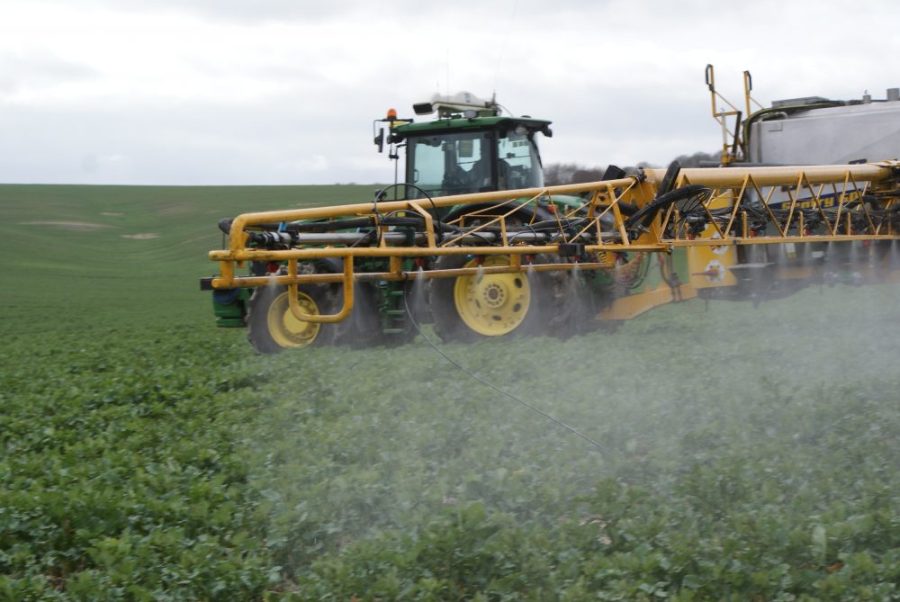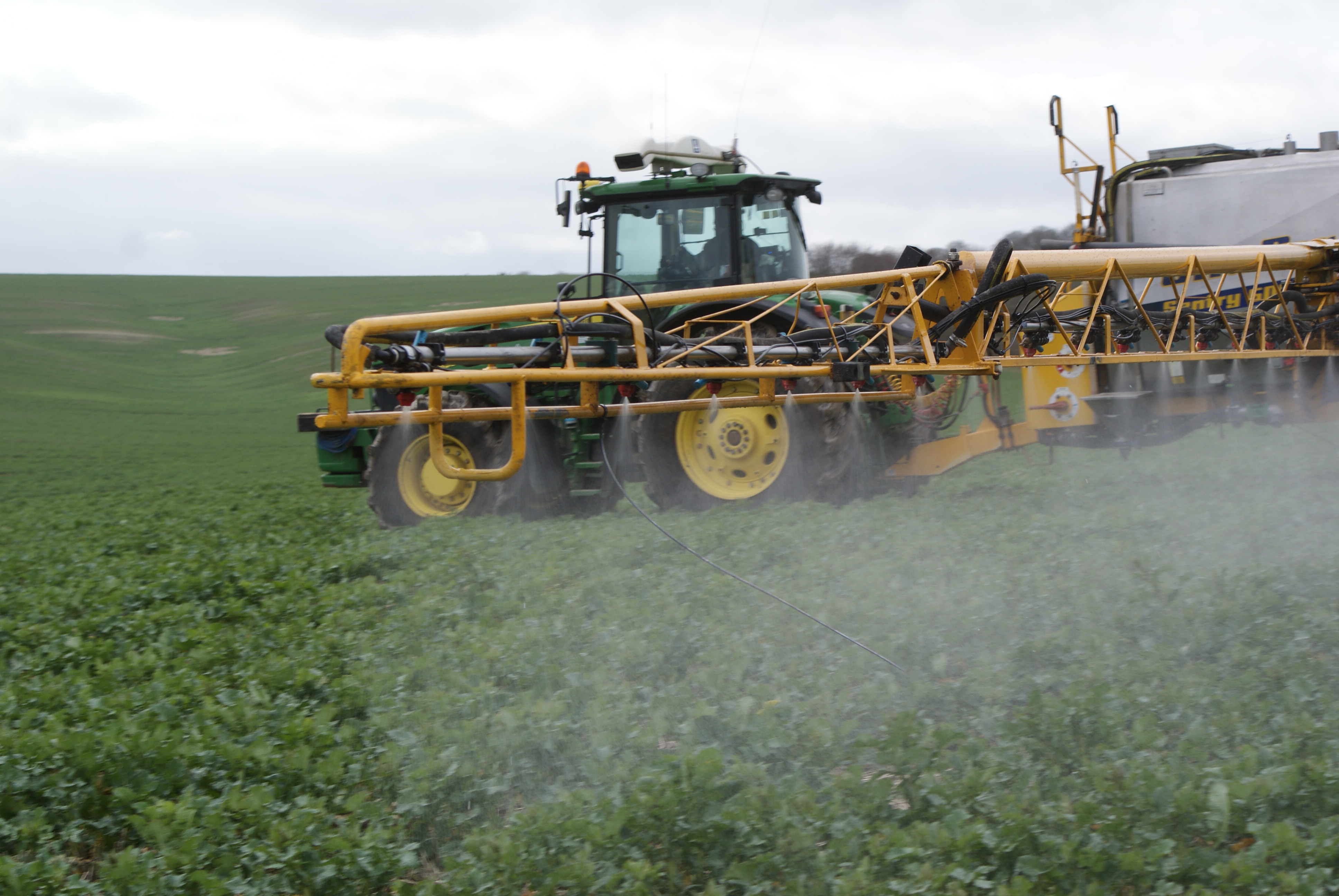
Light leaf spot will be number one agronomic priority in oilseed rape crops for some growers once early spring growth gets underway. CPM gathers some advice.
The most striking recent change is in the severity of the disease being observed.
By Tom Allen-Stevens and Rob Jones
Growers are advised to monitor oilseed rape fields closely for light leaf spot as crops begin to move this spring. Incubation of leaf samples is revealing levels of the disease may be higher than observed symptoms suggest.
The first lesions were found as early as mid-Nov during routine monitoring, conducted by ADAS, on susceptible varieties that hadn’t been fungicide treated. These were observed near ADAS Rosemaund, Herefords, with the first signs of LLS noted near ADAS High Mowthorpe, Yorks, in mid-Dec. These crops didn’t receive an autumn fungicide and represent a variety with an LLS rating of 5, according to the AHDB Recommended List.
“The most striking recent change is in the severity of the disease being observed before and after incubation,” notes ADAS senior pathologist Faye Ritchie. “Prior to incubation at one site in Yorks, 0.8% leaf area was affected. But after incubation for 48hrs this increased to 6.3% leaf area affected.”
This gives an early indication of the amount of disease likely to appear in the crop over the next few weeks, she explains. “The difference before and after incubation suggests that pressure is increasing.
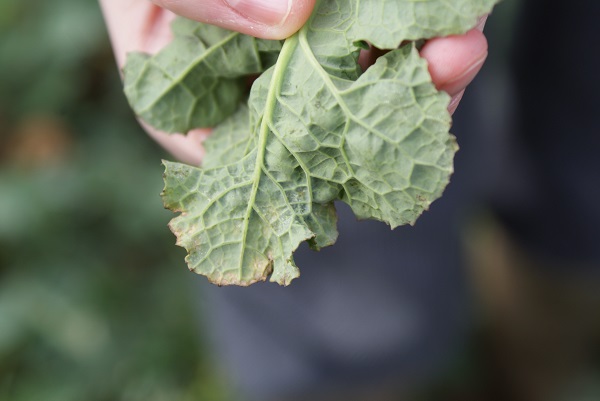
Infections can be difficult to detect at this time of year.
“It’s likely that LLS on more resistant varieties will be slower and also in crops that received an autumn fungicide, so monitoring will be key to determine when to apply fungicides this spring.” Symptoms tend to appear first and more severely in crops sown mid-Aug compared with those drilled in Sept.
Current LLS pressure is thought to be similar to last year’s, but how it then develops will depend on the season, continues Faye. “In spring 2017, results for crops reported as part of the Defra OSR disease survey in England showed that, where LLS had been reported in fields, only 15% of plants in those fields were affected. This was in contrast to previous survey years, which had reported over 30% plants affected since 2011.”
The reason for this, however, was the dry spring, which prevented the usual spread of the disease. “This wasn’t typical and it’s likely these levels will be exceeded this year if the weather remains favourable for disease development.”
LLS is a polycyclic disease, so once it infects a crop, it can be transferred by rain-splash to adjacent plants if conditions allow. Historically, it was most serious in Scotland and the north of England, but it’s now a problem throughout the UK and managed through using resistant varieties and fungicide sprays.
“Once the disease is established it cannot be eradicated. A standard two-spray programme, autumn followed by spring application, often doesn’t cover the whole epidemic, and we typically see 50-60% control of LLS.” Faye recommends spraying in the autumn then at the first sign of the disease, which can be prior to stem extension.
Bayer’s new SpotCheck service is indicating LLS levels may be higher than usual this year. The OSR leaf-sampling service gives growers and agronomists the opportunity to have leaves tested by ADAS experts for diseases, such as phoma, alternaria and downy mildew.
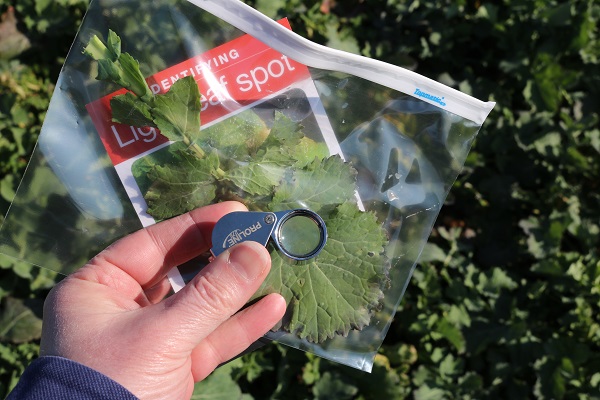
The new SpotCheck OSR leaf-sampling service gives growers and agronomists the opportunity to have leaves tested by ADAS experts for diseases.
But the primary focus is on LLS, and the latest results show 54 of the 70 samples received in Feb proved positive. Overall 40% of the 300 samples tested since the initiative started in Oct 2017 have been positive for LLS, including some in the first few samples, confirming what researchers anticipated – that LLS is present early in the autumn.
The surge in positive findings doesn’t surprise ADAS plant pathologist Philip Walker. “Following initial infection in the autumn, the disease is spread by rain-splashed spores, but this is often limited to close to the initial foci.
“Once symptoms are visible in the field, LLS can increase and spread quickly via rain-splash. A secondary release of wind-blown ascospores in the spring further facilitates its spread,” he notes.
Feb results reveal that of over 40 samples sent in from northern parts only six were free of the disease, but it also confirms the nationwide threat that LLS poses with the disease also being picked up in counties such as Dorset, Sussex, Oxon, Wilts, Cambs and Norfolk.
The service has been used widely by AICC agronomists, according to chairman Sean Sparling. He supplied samples from farms where he suspected the disease was present, but symptoms still had to express themselves. A number of positive results confirmed his suspicions. “SpotCheck means I now know of the presence of latent LLS and can tailor fungicide choice and dose to reflect the disease risk that OSR crops are facing,” he notes.
With the increase in positive samples, Bayer’s Darren Adkins says that the last thing growers want is the disease getting into the canopy. “If this happens it can be particularly devastating. You’ll only be able to protect new growth as eradication of the disease once established isn’t possible.
“Where the disease threatens go with a product with good LLS activity, such as prothioconazole now to protect current growth. This could be topped up with a growth regulatory and LLS active such as tebuconazole at stem-extension,” he says.
Conditions for clubroot were favourable in the autumn last year across the country, according to ADAS, and severely affected fields were reported. Underground symptoms on some crops are often not detected during autumn and winter and are only identified as other symptoms, such as stunting, becomes obvious as the crop starts to extend.
AHDB-funded sclerotinia monitoring, conducted by ADAS, starts from early March, reported as weather-based infection alerts via the AHDB website. What’s more, ADAS will also monitor sclerotial germination progress and test petals for spore inoculum at seven monitor sites, also ranging from SW England to Scottish borders. This is work funded by BASF with results reported weekly via the BASF website. Germination progress shows the onset of spore release across the country by region and petals tests at intervals during flowering will show the level of inoculum within monitor crops at intervals.
Shape OSR for even flowering
Oilseed rape crops that have been held in check by cold weather are poised for rapid growth, advises Syngenta field technical manager, James Southgate. But if the main raceme now shoots away, the yield potential of lower branches could be significantly reduced.
Well timed PGR applications could beneficially hold back the stem extension and enable the side shoots to develop simultaneously, establishing a stronger structure and leaf canopy to produce higher yields, he explains.
“Some of the more advanced crops could be expected to lose leaves in the bitterly cold easterly winds through the end of Feb and early March, but with well established root structures they’re well placed to recover quickly,” he points out.
“To encourage branching and even up the crop they’re really going to benefit from an early Toprex (difenoconazole+ paclobutrazol) application, from early stem extension (GS31).”
Smaller crops, with limited root reserves, however, need nurturing through the coming weeks to increase their green area, when they may then benefit from a later PGR application, from GS51, to develop shape and branching that’ll make the most of potential light interception, he advocates.
“With the extending day length, plants are poised to take off; as soon as temperatures rise crops will rapidly move through stem extension,” advises James. “Growers should be prepared to apply Toprex at the optimum point to shape canopy development.”
The objective is to trigger the crop into developing sufficient side shoots to bear seed pods, and the green leaf area to ensure seed fill and increase oil content.
“With a genuine PGR you can shape the crop to improve its overall efficiency. The use of Toprex encourages far greater consistency across the crop, so while the onset of flowering on the main raceme may be later, you then get all the side shoots flowering at a similar time – so the flowering is far more intense, but over a shorter period.”
The benefit for the crop is that the yellow flowers physically reflect sunlight, so a shorter duration of flowering means that plant’s green leaves are able to absorb and utilise more energy, he explains. It’s particularly evident where the PGR has encouraged stronger side branching and more accessible photosynthetic green leaf.
James adds that if some small crops continue to be slow to get going in the spring, they may be better left without PGR treatment. Ensuring they reach a Green Area Index of 3.5 by the start of flowering should be the priority, he urges.
Potential to build state of the nation’s OSR
Confidence in oilseed rape is growing, according to a survey carried out by BASF. But many growers feel there’s still much they can do to bring a reliable yield performance from their crops.
Planting surveys suggest the 2018 UK crop will exceed 600,000ha, notes BASF’s Jane Kitchen. “Interestingly, from the sample of 289 growers who responded to our survey, 20% are growing Clearfield varieties – we believe there’s around 60,000ha of Clearfield crop in the ground for 2018 harvest.”
Open-pollinated, certified varieties are proving most popular, however, with 53% of respondents growing these, while 46% are growing non-Clearfield hybrids (the sample includes those growing multiple variety types). A third have crops grown from farm-saved seed.
Looking ahead, 22% are planning to increase their area, while 15% of growers are looking to reduce or not grow OSR in 2019. Clearfield varieties are set to find favour again, with 26% of 2018 users planning to increase their area.
When asked about cabbage stem flea beetle, 71% of growers revealed they’d suffered pressure over the past three seasons. “But it looks as though there’s been a drop in the severity of pressure, with fewer growers suffering total crop failure.”
This could be down to growers finding better ways to manage the problem, with 69% using improved seedbeds and 55% higher seed rates. Earlier drilling was perceived as the most successful strategy, however.
“Crop performance has improved considerably between 2016 and 2017 (see chart below), but it’s clear that OSR is still seen as a challenging crop – there’s a big spread in yield from the bottom to the top, and a wealth of issues giving growers headaches and sleepless nights.”
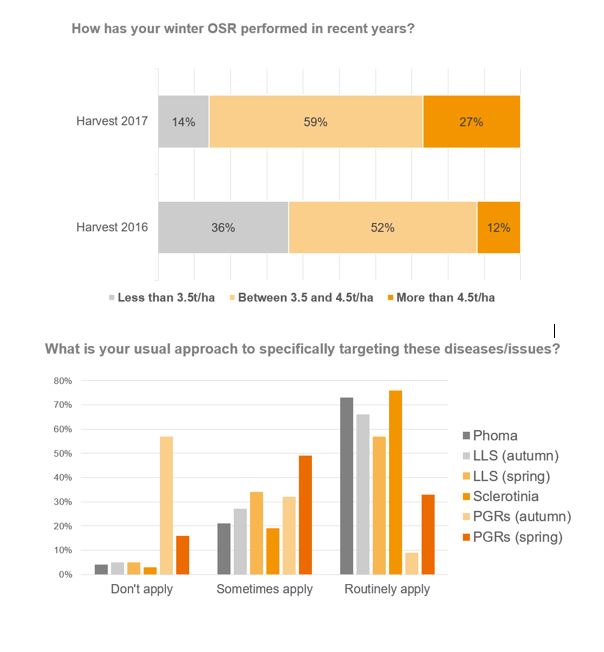
Source: BASF State of the Nation OSR survey, 2018
When asked about the agricultural industry’s understanding of winter wheat yield factors, 74% scored this 4 or 5 out of 5, while for OSR only 34% of respondents rated understanding so high.
“It underlines the importance of research, and getting the findings out to growers,” concludes Jane. The Real Results OSR site has been improved, she adds, with a calculator showing the expected losses from lodging and a calendar giving the key priorities for each month basfrealresults.co.uk/osr/

